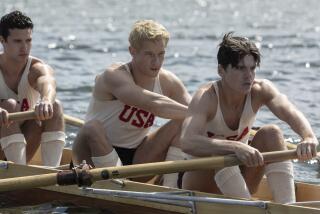Europeans Do What’s Expected as World Cup Sculls Debuts
- Share via
SAN DIEGO — In the first World Cup rowing event ever, Europeans proved their superiority in single sculling Saturday during the 17th San Diego Crew Classic in Mission Bay.
But give the U.S. rowers a break--Europeans have been rowing years before an average American even thinks about participating in the sport. Here, athletes usually are introduced to the sport in college, learning sweeping (one oar each) in an eight-man boat. If a person continues, he or she might eventually learn sculling (two oars).
In Europe, club competition is emphasised over college. The average rower starts at 12, with an immediate emphasis on sculling.
The inaugural World Cup--sponsored by FISA, the Lucerne, Switzerland-based international rowing organization--will consist of five races. San Diego is the only North American venue; the others will be Mannheim, West Germany, Oslo, Amsterdam and Lucerne.
Rowers will compile points with the idea of determining the best rower in the world. Well, that was the objective, but at least one of the top males is not participating. East Germany’s Thomas Lange, the 1989 world champion, is off until July so he can concentrate on medical school.
Vaclav Chalupa of Czechoslovakia won Saturday’s men’s race in 7:24.56 (2,000 meters). Chalupa was second to Lange at the 1989 world championships but later beat him. Their next meeting will probably be in the world championships in November.
All four American rowers failed to make the grand final and therefore made up the petite race. Dave Saxon of Seattle won in 7:39.87.
Elisabeta Lipa of Romania, the 1989 world champion, failed to make the women’s grand final, but that didn’t make the competition any easier according to winner Birgit Peter of East Germany.
Peter took the early lead but then dropped into third behind Silken Laumann of Canada and Hungary’s Katalin Sarlos. Laumann held the lead until Peter pulled ahead in the last 100 meters to win in 8:11.10. Laumann was second in 8:11.98, West Germany’s Titie Jordache third in 8:13.52.
“Yesterday’s race (during the heats) was very difficult, so the plan was to row economically,” Peter said through an interpreter. “The first 1,000 meters, I wanted to pace myself, then make my move in the second half.”
Kris Karlson of Weston, Conn., and Alison Townley of Belmont, Mass., first and second in the women’s petite race, are the only U.S. rowers, men or women, who will compete in another World Cup event. Cost is the main reason. Karlson and Townley plan to travel to Italy on Tuesday, compete in Mannheim in May and return for the national championships in Indianapolis in June.
Karlson, who failed to make the grand final (top six) by one-tenth of a second, won two lightweight gold medals, in single and double sculls, at the world championships last year, the only woman ever to do so.
Chris Korzeniowski, director of the U.S. national team, said he was pleased with Karlson’s performance Saturday considering that she was competing against rowers at least 20 pounds heavier. Korzeniowski said they have been working on increasing her weight because there is no lightweight competition in the Olympics.
More to Read
Go beyond the scoreboard
Get the latest on L.A.'s teams in the daily Sports Report newsletter.
You may occasionally receive promotional content from the Los Angeles Times.






